Global Supply Chain Management: A Retail Industry Analysis
VerifiedAdded on 2020/10/22
|13
|3974
|308
Report
AI Summary
This report provides a comprehensive analysis of global supply chain management within the retail sector. It explores the design and implementation of effective supply chain strategies, emphasizing the importance of integrating key business operations from raw material suppliers to end customers. The report delves into how organizations configure their supply chains through collaboration, lean principles, and agility to achieve competitive advantages. It also examines the utilization of advanced technologies, such as big data analytics, to optimize supply chain performance, reduce costs, and enhance decision-making. The SCOR model is discussed as a framework for strategic decision-making. The report highlights the significance of agility in responding to market volatility and the benefits of lean principles in eliminating waste. Furthermore, it emphasizes the role of collaboration in building strong relationships and the advantages of using advanced technologies like big data analytics and cloud computing for improved efficiency and customer satisfaction.
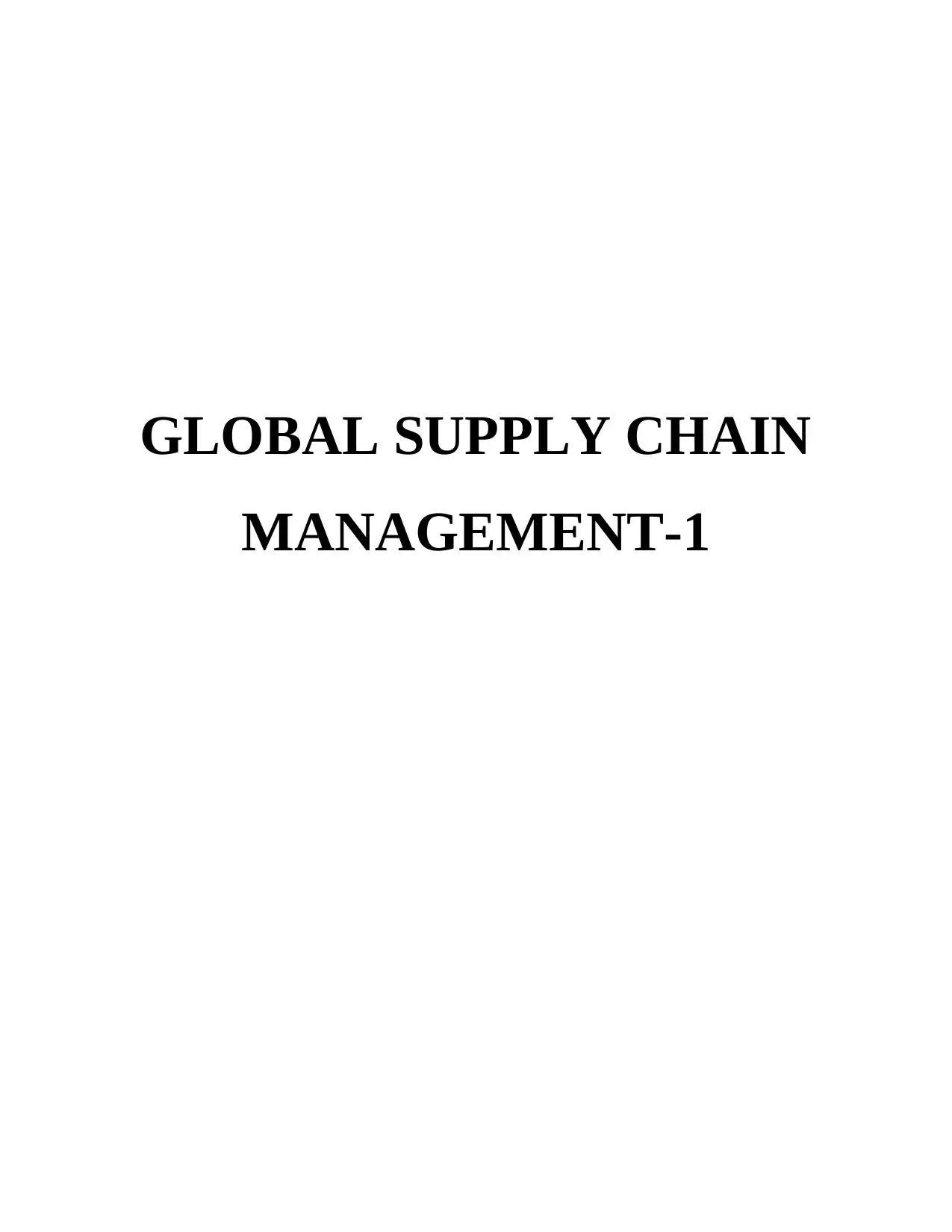
GLOBAL SUPPLY CHAIN
MANAGEMENT-1
MANAGEMENT-1
Paraphrase This Document
Need a fresh take? Get an instant paraphrase of this document with our AI Paraphraser
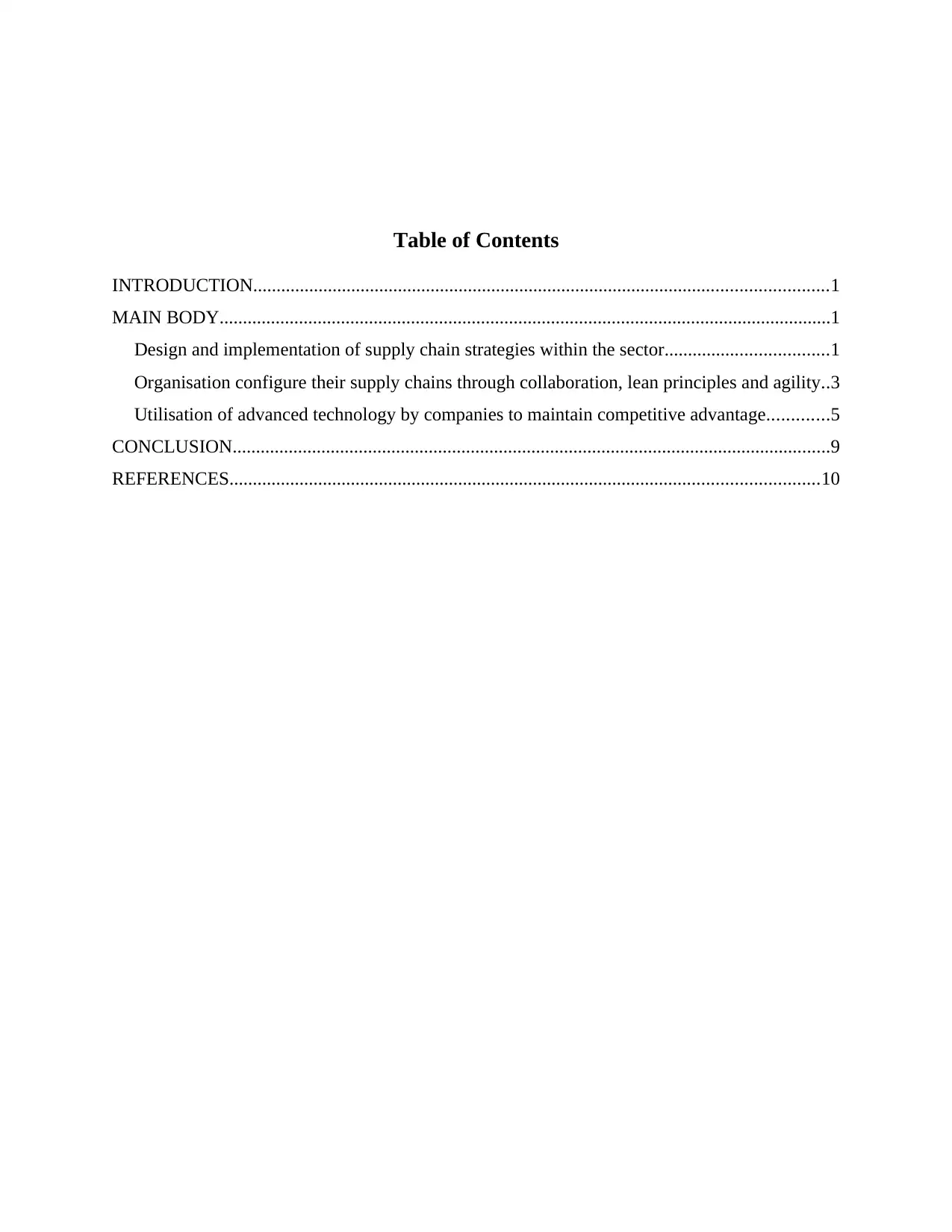
Table of Contents
INTRODUCTION...........................................................................................................................1
MAIN BODY...................................................................................................................................1
Design and implementation of supply chain strategies within the sector...................................1
Organisation configure their supply chains through collaboration, lean principles and agility..3
Utilisation of advanced technology by companies to maintain competitive advantage.............5
CONCLUSION................................................................................................................................9
REFERENCES..............................................................................................................................10
INTRODUCTION...........................................................................................................................1
MAIN BODY...................................................................................................................................1
Design and implementation of supply chain strategies within the sector...................................1
Organisation configure their supply chains through collaboration, lean principles and agility..3
Utilisation of advanced technology by companies to maintain competitive advantage.............5
CONCLUSION................................................................................................................................9
REFERENCES..............................................................................................................................10
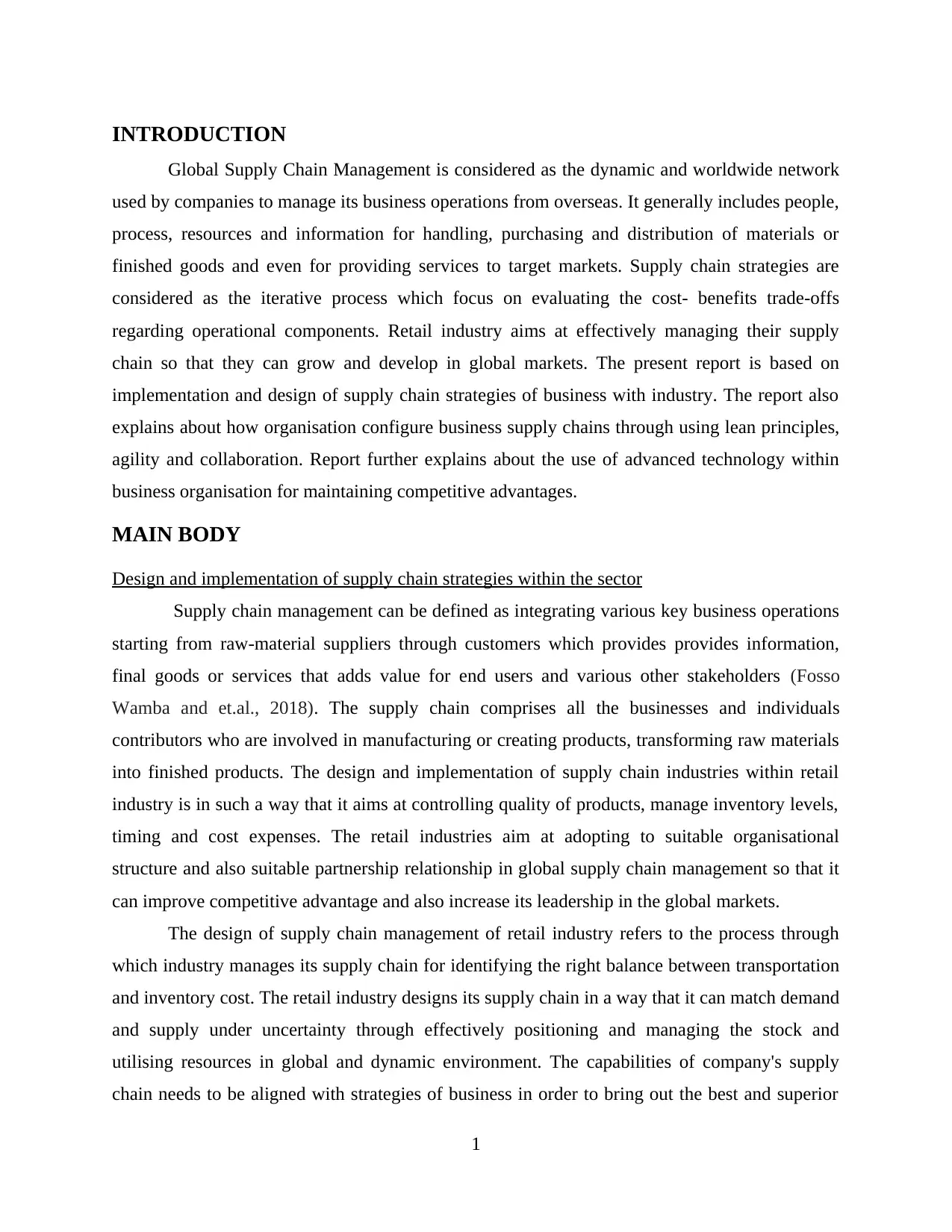
INTRODUCTION
Global Supply Chain Management is considered as the dynamic and worldwide network
used by companies to manage its business operations from overseas. It generally includes people,
process, resources and information for handling, purchasing and distribution of materials or
finished goods and even for providing services to target markets. Supply chain strategies are
considered as the iterative process which focus on evaluating the cost- benefits trade-offs
regarding operational components. Retail industry aims at effectively managing their supply
chain so that they can grow and develop in global markets. The present report is based on
implementation and design of supply chain strategies of business with industry. The report also
explains about how organisation configure business supply chains through using lean principles,
agility and collaboration. Report further explains about the use of advanced technology within
business organisation for maintaining competitive advantages.
MAIN BODY
Design and implementation of supply chain strategies within the sector
Supply chain management can be defined as integrating various key business operations
starting from raw-material suppliers through customers which provides provides information,
final goods or services that adds value for end users and various other stakeholders (Fosso
Wamba and et.al., 2018). The supply chain comprises all the businesses and individuals
contributors who are involved in manufacturing or creating products, transforming raw materials
into finished products. The design and implementation of supply chain industries within retail
industry is in such a way that it aims at controlling quality of products, manage inventory levels,
timing and cost expenses. The retail industries aim at adopting to suitable organisational
structure and also suitable partnership relationship in global supply chain management so that it
can improve competitive advantage and also increase its leadership in the global markets.
The design of supply chain management of retail industry refers to the process through
which industry manages its supply chain for identifying the right balance between transportation
and inventory cost. The retail industry designs its supply chain in a way that it can match demand
and supply under uncertainty through effectively positioning and managing the stock and
utilising resources in global and dynamic environment. The capabilities of company's supply
chain needs to be aligned with strategies of business in order to bring out the best and superior
1
Global Supply Chain Management is considered as the dynamic and worldwide network
used by companies to manage its business operations from overseas. It generally includes people,
process, resources and information for handling, purchasing and distribution of materials or
finished goods and even for providing services to target markets. Supply chain strategies are
considered as the iterative process which focus on evaluating the cost- benefits trade-offs
regarding operational components. Retail industry aims at effectively managing their supply
chain so that they can grow and develop in global markets. The present report is based on
implementation and design of supply chain strategies of business with industry. The report also
explains about how organisation configure business supply chains through using lean principles,
agility and collaboration. Report further explains about the use of advanced technology within
business organisation for maintaining competitive advantages.
MAIN BODY
Design and implementation of supply chain strategies within the sector
Supply chain management can be defined as integrating various key business operations
starting from raw-material suppliers through customers which provides provides information,
final goods or services that adds value for end users and various other stakeholders (Fosso
Wamba and et.al., 2018). The supply chain comprises all the businesses and individuals
contributors who are involved in manufacturing or creating products, transforming raw materials
into finished products. The design and implementation of supply chain industries within retail
industry is in such a way that it aims at controlling quality of products, manage inventory levels,
timing and cost expenses. The retail industries aim at adopting to suitable organisational
structure and also suitable partnership relationship in global supply chain management so that it
can improve competitive advantage and also increase its leadership in the global markets.
The design of supply chain management of retail industry refers to the process through
which industry manages its supply chain for identifying the right balance between transportation
and inventory cost. The retail industry designs its supply chain in a way that it can match demand
and supply under uncertainty through effectively positioning and managing the stock and
utilising resources in global and dynamic environment. The capabilities of company's supply
chain needs to be aligned with strategies of business in order to bring out the best and superior
1
⊘ This is a preview!⊘
Do you want full access?
Subscribe today to unlock all pages.

Trusted by 1+ million students worldwide
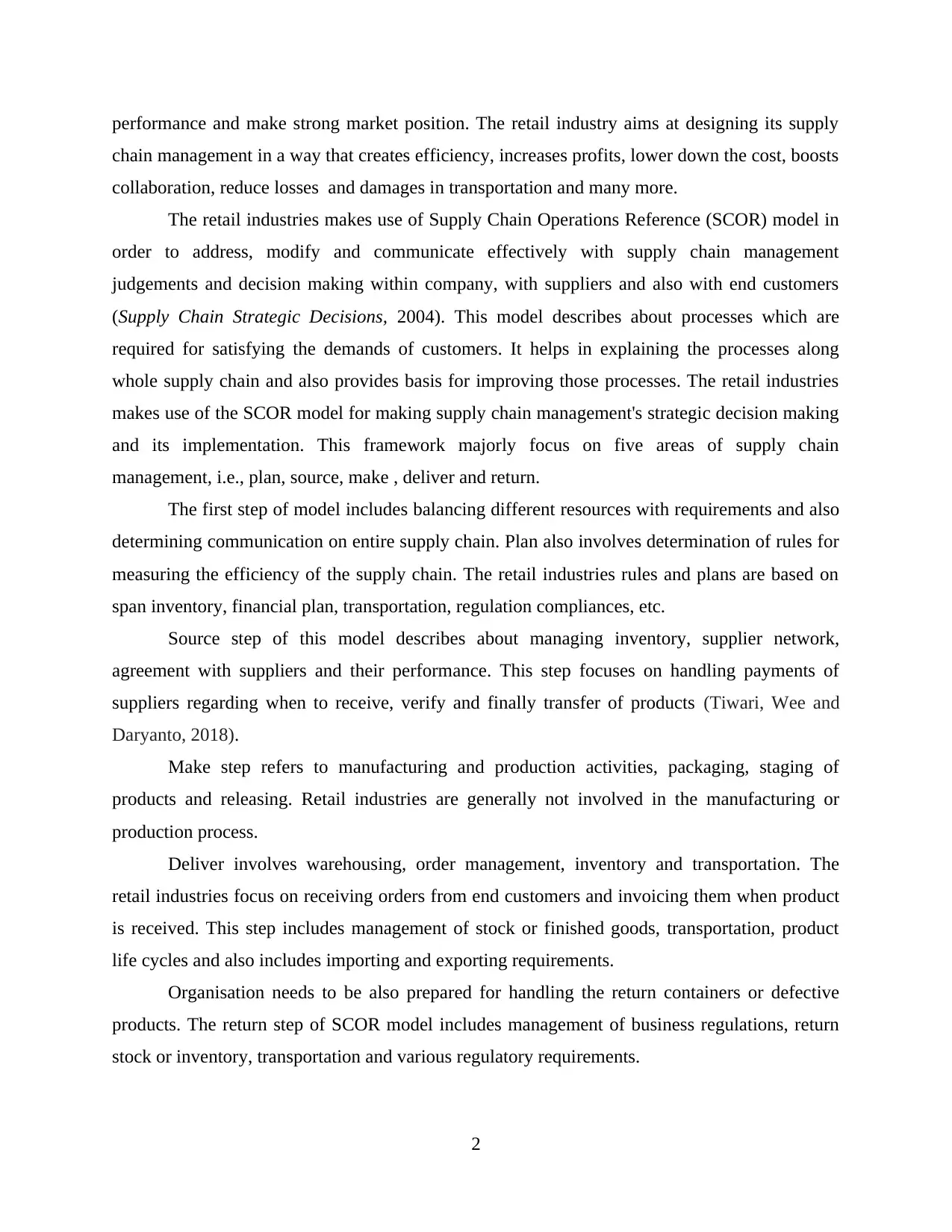
performance and make strong market position. The retail industry aims at designing its supply
chain management in a way that creates efficiency, increases profits, lower down the cost, boosts
collaboration, reduce losses and damages in transportation and many more.
The retail industries makes use of Supply Chain Operations Reference (SCOR) model in
order to address, modify and communicate effectively with supply chain management
judgements and decision making within company, with suppliers and also with end customers
(Supply Chain Strategic Decisions, 2004). This model describes about processes which are
required for satisfying the demands of customers. It helps in explaining the processes along
whole supply chain and also provides basis for improving those processes. The retail industries
makes use of the SCOR model for making supply chain management's strategic decision making
and its implementation. This framework majorly focus on five areas of supply chain
management, i.e., plan, source, make , deliver and return.
The first step of model includes balancing different resources with requirements and also
determining communication on entire supply chain. Plan also involves determination of rules for
measuring the efficiency of the supply chain. The retail industries rules and plans are based on
span inventory, financial plan, transportation, regulation compliances, etc.
Source step of this model describes about managing inventory, supplier network,
agreement with suppliers and their performance. This step focuses on handling payments of
suppliers regarding when to receive, verify and finally transfer of products (Tiwari, Wee and
Daryanto, 2018).
Make step refers to manufacturing and production activities, packaging, staging of
products and releasing. Retail industries are generally not involved in the manufacturing or
production process.
Deliver involves warehousing, order management, inventory and transportation. The
retail industries focus on receiving orders from end customers and invoicing them when product
is received. This step includes management of stock or finished goods, transportation, product
life cycles and also includes importing and exporting requirements.
Organisation needs to be also prepared for handling the return containers or defective
products. The return step of SCOR model includes management of business regulations, return
stock or inventory, transportation and various regulatory requirements.
2
chain management in a way that creates efficiency, increases profits, lower down the cost, boosts
collaboration, reduce losses and damages in transportation and many more.
The retail industries makes use of Supply Chain Operations Reference (SCOR) model in
order to address, modify and communicate effectively with supply chain management
judgements and decision making within company, with suppliers and also with end customers
(Supply Chain Strategic Decisions, 2004). This model describes about processes which are
required for satisfying the demands of customers. It helps in explaining the processes along
whole supply chain and also provides basis for improving those processes. The retail industries
makes use of the SCOR model for making supply chain management's strategic decision making
and its implementation. This framework majorly focus on five areas of supply chain
management, i.e., plan, source, make , deliver and return.
The first step of model includes balancing different resources with requirements and also
determining communication on entire supply chain. Plan also involves determination of rules for
measuring the efficiency of the supply chain. The retail industries rules and plans are based on
span inventory, financial plan, transportation, regulation compliances, etc.
Source step of this model describes about managing inventory, supplier network,
agreement with suppliers and their performance. This step focuses on handling payments of
suppliers regarding when to receive, verify and finally transfer of products (Tiwari, Wee and
Daryanto, 2018).
Make step refers to manufacturing and production activities, packaging, staging of
products and releasing. Retail industries are generally not involved in the manufacturing or
production process.
Deliver involves warehousing, order management, inventory and transportation. The
retail industries focus on receiving orders from end customers and invoicing them when product
is received. This step includes management of stock or finished goods, transportation, product
life cycles and also includes importing and exporting requirements.
Organisation needs to be also prepared for handling the return containers or defective
products. The return step of SCOR model includes management of business regulations, return
stock or inventory, transportation and various regulatory requirements.
2
Paraphrase This Document
Need a fresh take? Get an instant paraphrase of this document with our AI Paraphraser
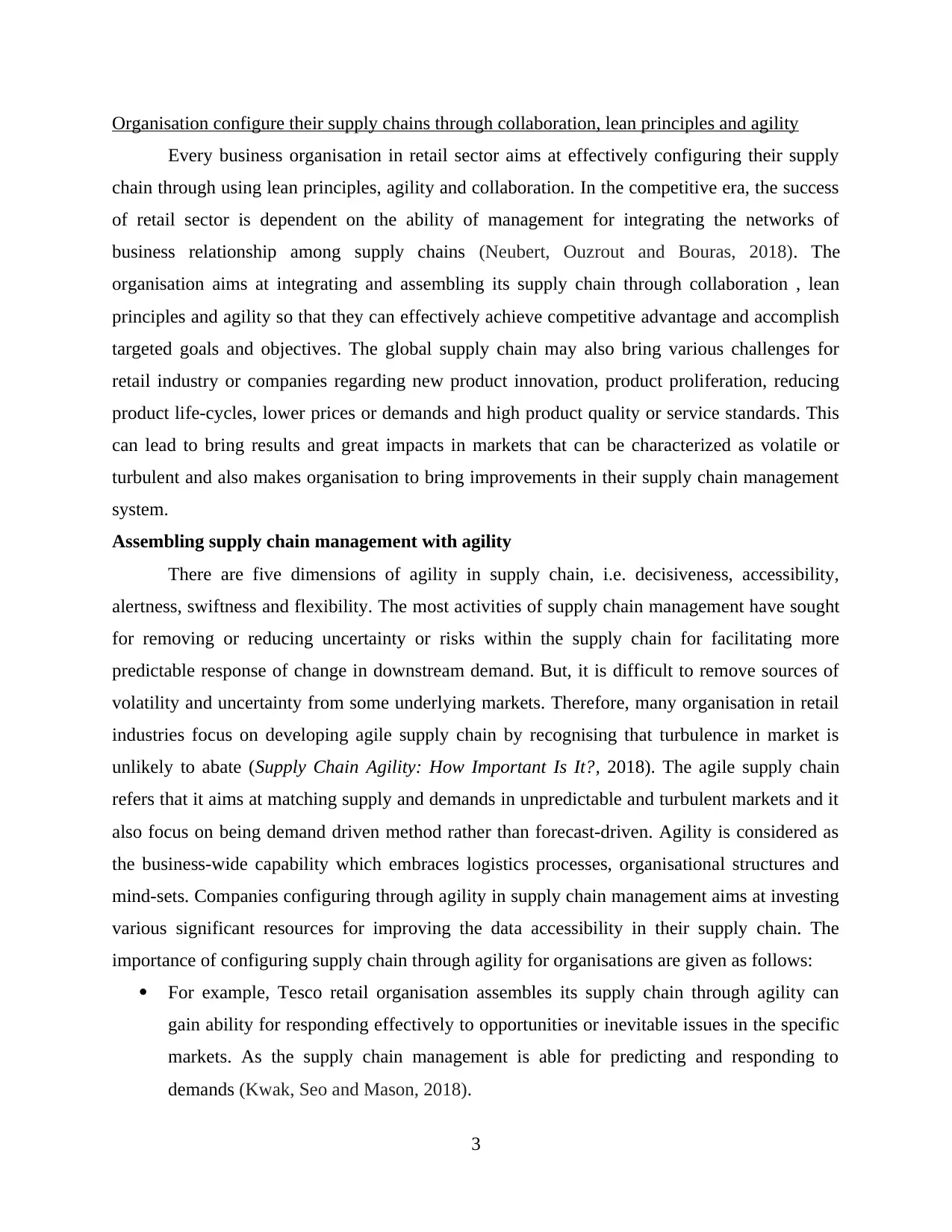
Organisation configure their supply chains through collaboration, lean principles and agility
Every business organisation in retail sector aims at effectively configuring their supply
chain through using lean principles, agility and collaboration. In the competitive era, the success
of retail sector is dependent on the ability of management for integrating the networks of
business relationship among supply chains (Neubert, Ouzrout and Bouras, 2018). The
organisation aims at integrating and assembling its supply chain through collaboration , lean
principles and agility so that they can effectively achieve competitive advantage and accomplish
targeted goals and objectives. The global supply chain may also bring various challenges for
retail industry or companies regarding new product innovation, product proliferation, reducing
product life-cycles, lower prices or demands and high product quality or service standards. This
can lead to bring results and great impacts in markets that can be characterized as volatile or
turbulent and also makes organisation to bring improvements in their supply chain management
system.
Assembling supply chain management with agility
There are five dimensions of agility in supply chain, i.e. decisiveness, accessibility,
alertness, swiftness and flexibility. The most activities of supply chain management have sought
for removing or reducing uncertainty or risks within the supply chain for facilitating more
predictable response of change in downstream demand. But, it is difficult to remove sources of
volatility and uncertainty from some underlying markets. Therefore, many organisation in retail
industries focus on developing agile supply chain by recognising that turbulence in market is
unlikely to abate (Supply Chain Agility: How Important Is It?, 2018). The agile supply chain
refers that it aims at matching supply and demands in unpredictable and turbulent markets and it
also focus on being demand driven method rather than forecast-driven. Agility is considered as
the business-wide capability which embraces logistics processes, organisational structures and
mind-sets. Companies configuring through agility in supply chain management aims at investing
various significant resources for improving the data accessibility in their supply chain. The
importance of configuring supply chain through agility for organisations are given as follows:
For example, Tesco retail organisation assembles its supply chain through agility can
gain ability for responding effectively to opportunities or inevitable issues in the specific
markets. As the supply chain management is able for predicting and responding to
demands (Kwak, Seo and Mason, 2018).
3
Every business organisation in retail sector aims at effectively configuring their supply
chain through using lean principles, agility and collaboration. In the competitive era, the success
of retail sector is dependent on the ability of management for integrating the networks of
business relationship among supply chains (Neubert, Ouzrout and Bouras, 2018). The
organisation aims at integrating and assembling its supply chain through collaboration , lean
principles and agility so that they can effectively achieve competitive advantage and accomplish
targeted goals and objectives. The global supply chain may also bring various challenges for
retail industry or companies regarding new product innovation, product proliferation, reducing
product life-cycles, lower prices or demands and high product quality or service standards. This
can lead to bring results and great impacts in markets that can be characterized as volatile or
turbulent and also makes organisation to bring improvements in their supply chain management
system.
Assembling supply chain management with agility
There are five dimensions of agility in supply chain, i.e. decisiveness, accessibility,
alertness, swiftness and flexibility. The most activities of supply chain management have sought
for removing or reducing uncertainty or risks within the supply chain for facilitating more
predictable response of change in downstream demand. But, it is difficult to remove sources of
volatility and uncertainty from some underlying markets. Therefore, many organisation in retail
industries focus on developing agile supply chain by recognising that turbulence in market is
unlikely to abate (Supply Chain Agility: How Important Is It?, 2018). The agile supply chain
refers that it aims at matching supply and demands in unpredictable and turbulent markets and it
also focus on being demand driven method rather than forecast-driven. Agility is considered as
the business-wide capability which embraces logistics processes, organisational structures and
mind-sets. Companies configuring through agility in supply chain management aims at investing
various significant resources for improving the data accessibility in their supply chain. The
importance of configuring supply chain through agility for organisations are given as follows:
For example, Tesco retail organisation assembles its supply chain through agility can
gain ability for responding effectively to opportunities or inevitable issues in the specific
markets. As the supply chain management is able for predicting and responding to
demands (Kwak, Seo and Mason, 2018).
3
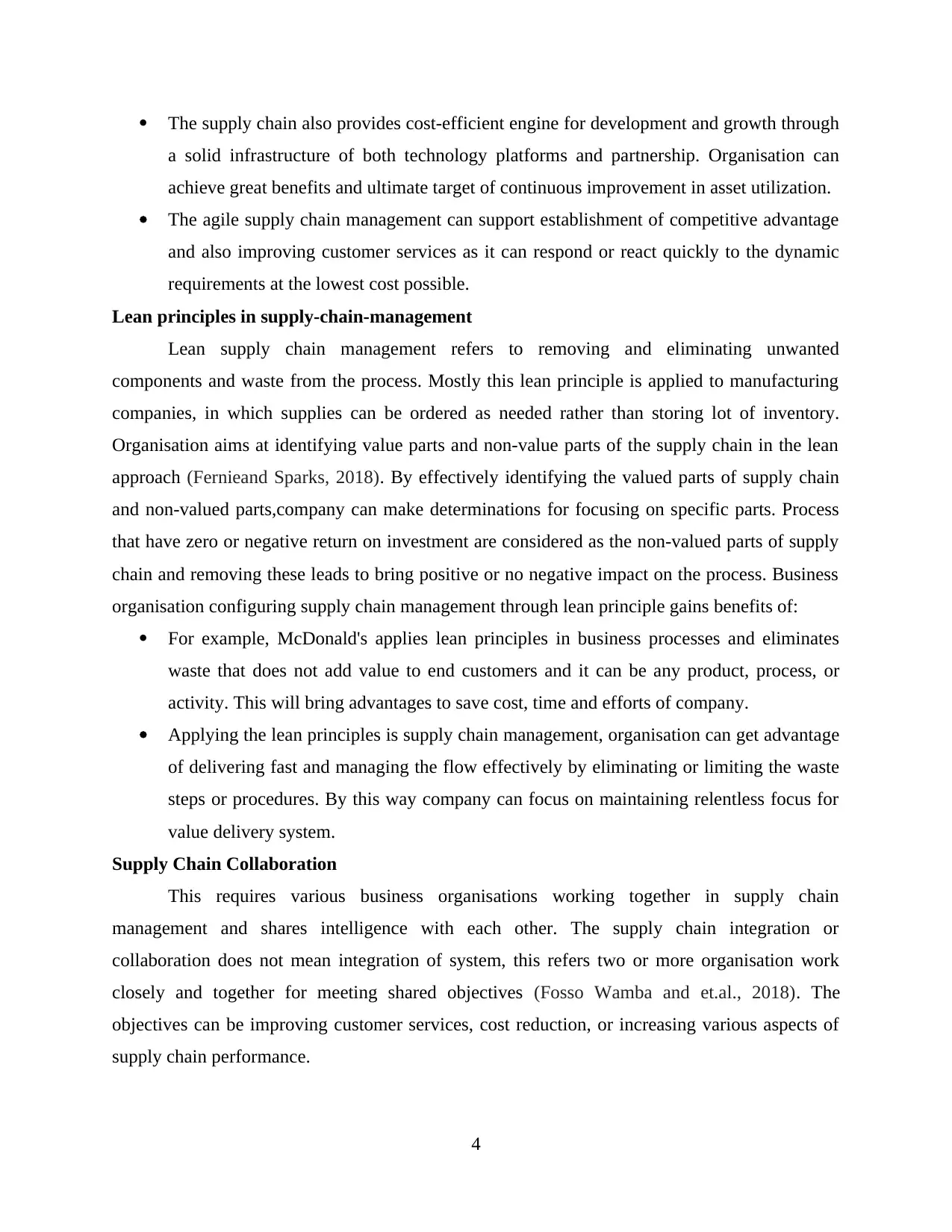
The supply chain also provides cost-efficient engine for development and growth through
a solid infrastructure of both technology platforms and partnership. Organisation can
achieve great benefits and ultimate target of continuous improvement in asset utilization.
The agile supply chain management can support establishment of competitive advantage
and also improving customer services as it can respond or react quickly to the dynamic
requirements at the lowest cost possible.
Lean principles in supply-chain-management
Lean supply chain management refers to removing and eliminating unwanted
components and waste from the process. Mostly this lean principle is applied to manufacturing
companies, in which supplies can be ordered as needed rather than storing lot of inventory.
Organisation aims at identifying value parts and non-value parts of the supply chain in the lean
approach (Fernieand Sparks, 2018). By effectively identifying the valued parts of supply chain
and non-valued parts,company can make determinations for focusing on specific parts. Process
that have zero or negative return on investment are considered as the non-valued parts of supply
chain and removing these leads to bring positive or no negative impact on the process. Business
organisation configuring supply chain management through lean principle gains benefits of:
For example, McDonald's applies lean principles in business processes and eliminates
waste that does not add value to end customers and it can be any product, process, or
activity. This will bring advantages to save cost, time and efforts of company.
Applying the lean principles is supply chain management, organisation can get advantage
of delivering fast and managing the flow effectively by eliminating or limiting the waste
steps or procedures. By this way company can focus on maintaining relentless focus for
value delivery system.
Supply Chain Collaboration
This requires various business organisations working together in supply chain
management and shares intelligence with each other. The supply chain integration or
collaboration does not mean integration of system, this refers two or more organisation work
closely and together for meeting shared objectives (Fosso Wamba and et.al., 2018). The
objectives can be improving customer services, cost reduction, or increasing various aspects of
supply chain performance.
4
a solid infrastructure of both technology platforms and partnership. Organisation can
achieve great benefits and ultimate target of continuous improvement in asset utilization.
The agile supply chain management can support establishment of competitive advantage
and also improving customer services as it can respond or react quickly to the dynamic
requirements at the lowest cost possible.
Lean principles in supply-chain-management
Lean supply chain management refers to removing and eliminating unwanted
components and waste from the process. Mostly this lean principle is applied to manufacturing
companies, in which supplies can be ordered as needed rather than storing lot of inventory.
Organisation aims at identifying value parts and non-value parts of the supply chain in the lean
approach (Fernieand Sparks, 2018). By effectively identifying the valued parts of supply chain
and non-valued parts,company can make determinations for focusing on specific parts. Process
that have zero or negative return on investment are considered as the non-valued parts of supply
chain and removing these leads to bring positive or no negative impact on the process. Business
organisation configuring supply chain management through lean principle gains benefits of:
For example, McDonald's applies lean principles in business processes and eliminates
waste that does not add value to end customers and it can be any product, process, or
activity. This will bring advantages to save cost, time and efforts of company.
Applying the lean principles is supply chain management, organisation can get advantage
of delivering fast and managing the flow effectively by eliminating or limiting the waste
steps or procedures. By this way company can focus on maintaining relentless focus for
value delivery system.
Supply Chain Collaboration
This requires various business organisations working together in supply chain
management and shares intelligence with each other. The supply chain integration or
collaboration does not mean integration of system, this refers two or more organisation work
closely and together for meeting shared objectives (Fosso Wamba and et.al., 2018). The
objectives can be improving customer services, cost reduction, or increasing various aspects of
supply chain performance.
4
⊘ This is a preview!⊘
Do you want full access?
Subscribe today to unlock all pages.

Trusted by 1+ million students worldwide
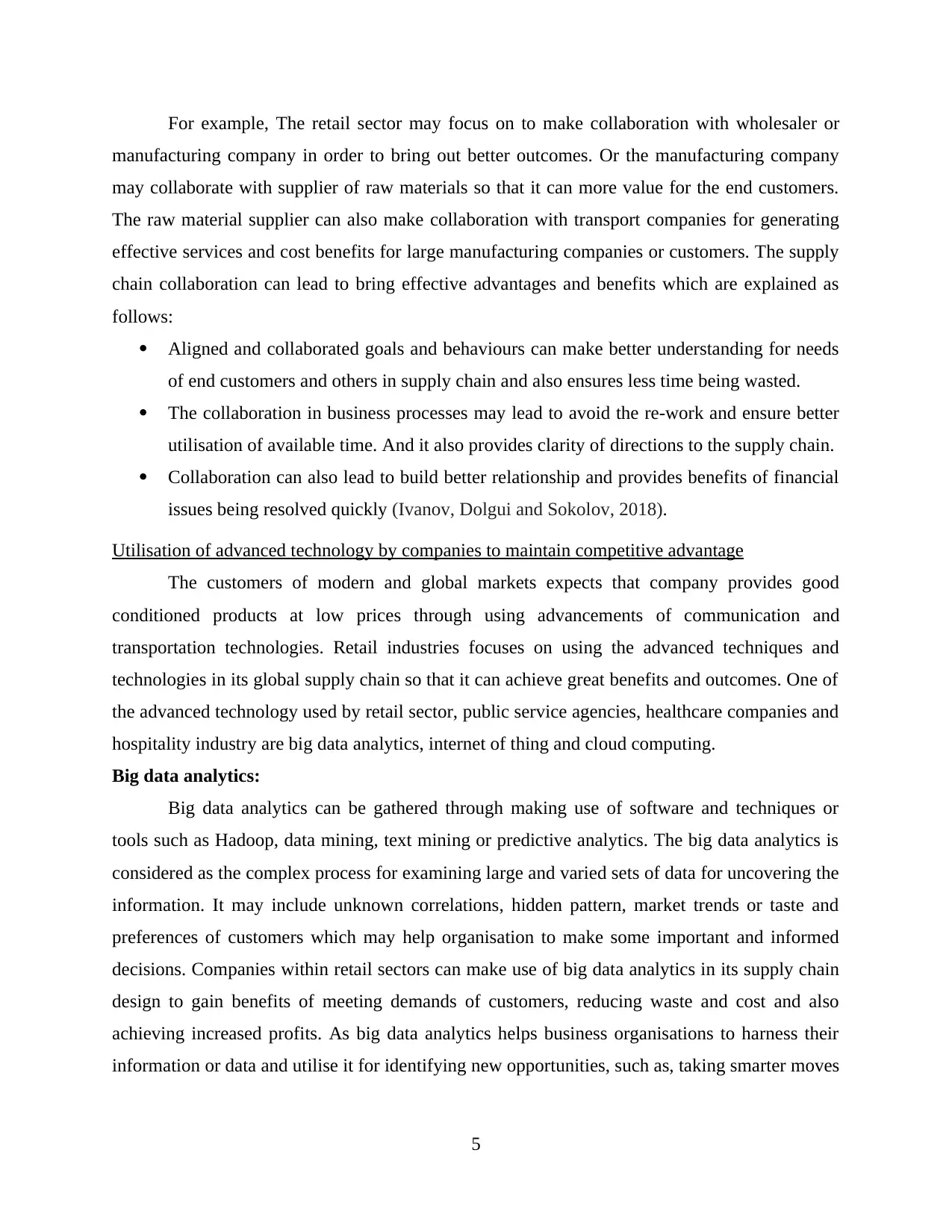
For example, The retail sector may focus on to make collaboration with wholesaler or
manufacturing company in order to bring out better outcomes. Or the manufacturing company
may collaborate with supplier of raw materials so that it can more value for the end customers.
The raw material supplier can also make collaboration with transport companies for generating
effective services and cost benefits for large manufacturing companies or customers. The supply
chain collaboration can lead to bring effective advantages and benefits which are explained as
follows:
Aligned and collaborated goals and behaviours can make better understanding for needs
of end customers and others in supply chain and also ensures less time being wasted.
The collaboration in business processes may lead to avoid the re-work and ensure better
utilisation of available time. And it also provides clarity of directions to the supply chain.
Collaboration can also lead to build better relationship and provides benefits of financial
issues being resolved quickly (Ivanov, Dolgui and Sokolov, 2018).
Utilisation of advanced technology by companies to maintain competitive advantage
The customers of modern and global markets expects that company provides good
conditioned products at low prices through using advancements of communication and
transportation technologies. Retail industries focuses on using the advanced techniques and
technologies in its global supply chain so that it can achieve great benefits and outcomes. One of
the advanced technology used by retail sector, public service agencies, healthcare companies and
hospitality industry are big data analytics, internet of thing and cloud computing.
Big data analytics:
Big data analytics can be gathered through making use of software and techniques or
tools such as Hadoop, data mining, text mining or predictive analytics. The big data analytics is
considered as the complex process for examining large and varied sets of data for uncovering the
information. It may include unknown correlations, hidden pattern, market trends or taste and
preferences of customers which may help organisation to make some important and informed
decisions. Companies within retail sectors can make use of big data analytics in its supply chain
design to gain benefits of meeting demands of customers, reducing waste and cost and also
achieving increased profits. As big data analytics helps business organisations to harness their
information or data and utilise it for identifying new opportunities, such as, taking smarter moves
5
manufacturing company in order to bring out better outcomes. Or the manufacturing company
may collaborate with supplier of raw materials so that it can more value for the end customers.
The raw material supplier can also make collaboration with transport companies for generating
effective services and cost benefits for large manufacturing companies or customers. The supply
chain collaboration can lead to bring effective advantages and benefits which are explained as
follows:
Aligned and collaborated goals and behaviours can make better understanding for needs
of end customers and others in supply chain and also ensures less time being wasted.
The collaboration in business processes may lead to avoid the re-work and ensure better
utilisation of available time. And it also provides clarity of directions to the supply chain.
Collaboration can also lead to build better relationship and provides benefits of financial
issues being resolved quickly (Ivanov, Dolgui and Sokolov, 2018).
Utilisation of advanced technology by companies to maintain competitive advantage
The customers of modern and global markets expects that company provides good
conditioned products at low prices through using advancements of communication and
transportation technologies. Retail industries focuses on using the advanced techniques and
technologies in its global supply chain so that it can achieve great benefits and outcomes. One of
the advanced technology used by retail sector, public service agencies, healthcare companies and
hospitality industry are big data analytics, internet of thing and cloud computing.
Big data analytics:
Big data analytics can be gathered through making use of software and techniques or
tools such as Hadoop, data mining, text mining or predictive analytics. The big data analytics is
considered as the complex process for examining large and varied sets of data for uncovering the
information. It may include unknown correlations, hidden pattern, market trends or taste and
preferences of customers which may help organisation to make some important and informed
decisions. Companies within retail sectors can make use of big data analytics in its supply chain
design to gain benefits of meeting demands of customers, reducing waste and cost and also
achieving increased profits. As big data analytics helps business organisations to harness their
information or data and utilise it for identifying new opportunities, such as, taking smarter moves
5
Paraphrase This Document
Need a fresh take? Get an instant paraphrase of this document with our AI Paraphraser
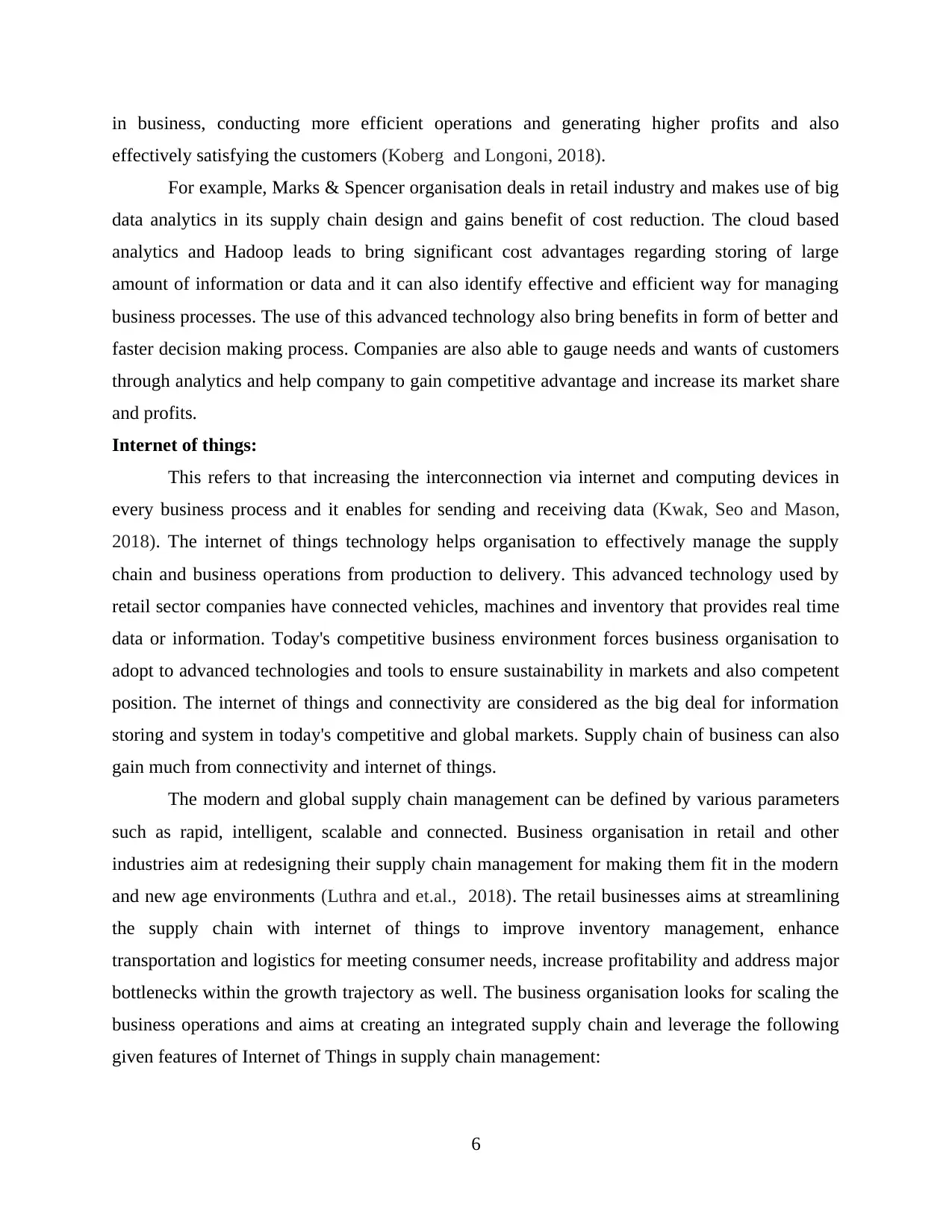
in business, conducting more efficient operations and generating higher profits and also
effectively satisfying the customers (Koberg and Longoni, 2018).
For example, Marks & Spencer organisation deals in retail industry and makes use of big
data analytics in its supply chain design and gains benefit of cost reduction. The cloud based
analytics and Hadoop leads to bring significant cost advantages regarding storing of large
amount of information or data and it can also identify effective and efficient way for managing
business processes. The use of this advanced technology also bring benefits in form of better and
faster decision making process. Companies are also able to gauge needs and wants of customers
through analytics and help company to gain competitive advantage and increase its market share
and profits.
Internet of things:
This refers to that increasing the interconnection via internet and computing devices in
every business process and it enables for sending and receiving data (Kwak, Seo and Mason,
2018). The internet of things technology helps organisation to effectively manage the supply
chain and business operations from production to delivery. This advanced technology used by
retail sector companies have connected vehicles, machines and inventory that provides real time
data or information. Today's competitive business environment forces business organisation to
adopt to advanced technologies and tools to ensure sustainability in markets and also competent
position. The internet of things and connectivity are considered as the big deal for information
storing and system in today's competitive and global markets. Supply chain of business can also
gain much from connectivity and internet of things.
The modern and global supply chain management can be defined by various parameters
such as rapid, intelligent, scalable and connected. Business organisation in retail and other
industries aim at redesigning their supply chain management for making them fit in the modern
and new age environments (Luthra and et.al., 2018). The retail businesses aims at streamlining
the supply chain with internet of things to improve inventory management, enhance
transportation and logistics for meeting consumer needs, increase profitability and address major
bottlenecks within the growth trajectory as well. The business organisation looks for scaling the
business operations and aims at creating an integrated supply chain and leverage the following
given features of Internet of Things in supply chain management:
6
effectively satisfying the customers (Koberg and Longoni, 2018).
For example, Marks & Spencer organisation deals in retail industry and makes use of big
data analytics in its supply chain design and gains benefit of cost reduction. The cloud based
analytics and Hadoop leads to bring significant cost advantages regarding storing of large
amount of information or data and it can also identify effective and efficient way for managing
business processes. The use of this advanced technology also bring benefits in form of better and
faster decision making process. Companies are also able to gauge needs and wants of customers
through analytics and help company to gain competitive advantage and increase its market share
and profits.
Internet of things:
This refers to that increasing the interconnection via internet and computing devices in
every business process and it enables for sending and receiving data (Kwak, Seo and Mason,
2018). The internet of things technology helps organisation to effectively manage the supply
chain and business operations from production to delivery. This advanced technology used by
retail sector companies have connected vehicles, machines and inventory that provides real time
data or information. Today's competitive business environment forces business organisation to
adopt to advanced technologies and tools to ensure sustainability in markets and also competent
position. The internet of things and connectivity are considered as the big deal for information
storing and system in today's competitive and global markets. Supply chain of business can also
gain much from connectivity and internet of things.
The modern and global supply chain management can be defined by various parameters
such as rapid, intelligent, scalable and connected. Business organisation in retail and other
industries aim at redesigning their supply chain management for making them fit in the modern
and new age environments (Luthra and et.al., 2018). The retail businesses aims at streamlining
the supply chain with internet of things to improve inventory management, enhance
transportation and logistics for meeting consumer needs, increase profitability and address major
bottlenecks within the growth trajectory as well. The business organisation looks for scaling the
business operations and aims at creating an integrated supply chain and leverage the following
given features of Internet of Things in supply chain management:
6
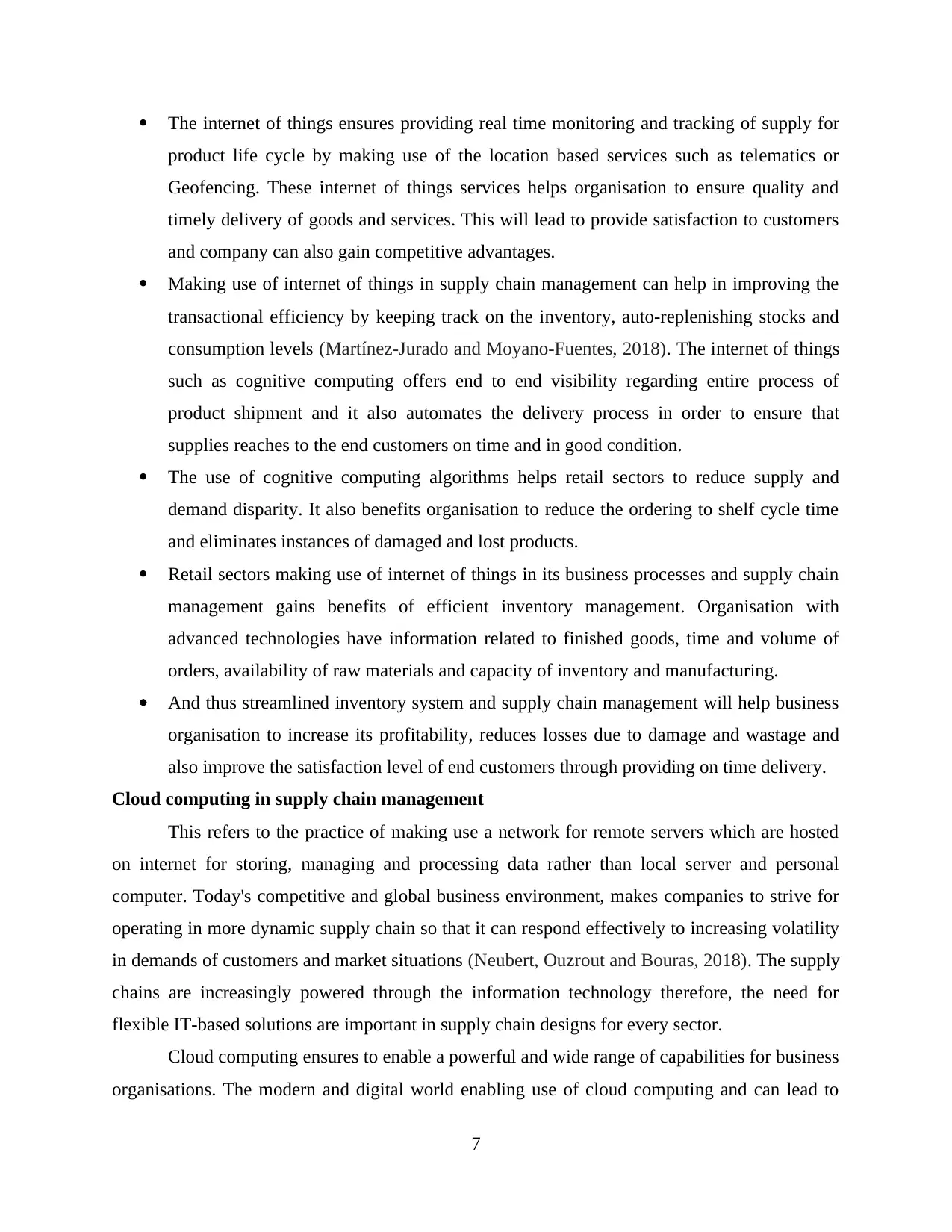
The internet of things ensures providing real time monitoring and tracking of supply for
product life cycle by making use of the location based services such as telematics or
Geofencing. These internet of things services helps organisation to ensure quality and
timely delivery of goods and services. This will lead to provide satisfaction to customers
and company can also gain competitive advantages.
Making use of internet of things in supply chain management can help in improving the
transactional efficiency by keeping track on the inventory, auto-replenishing stocks and
consumption levels (Martínez-Jurado and Moyano-Fuentes, 2018). The internet of things
such as cognitive computing offers end to end visibility regarding entire process of
product shipment and it also automates the delivery process in order to ensure that
supplies reaches to the end customers on time and in good condition.
The use of cognitive computing algorithms helps retail sectors to reduce supply and
demand disparity. It also benefits organisation to reduce the ordering to shelf cycle time
and eliminates instances of damaged and lost products.
Retail sectors making use of internet of things in its business processes and supply chain
management gains benefits of efficient inventory management. Organisation with
advanced technologies have information related to finished goods, time and volume of
orders, availability of raw materials and capacity of inventory and manufacturing.
And thus streamlined inventory system and supply chain management will help business
organisation to increase its profitability, reduces losses due to damage and wastage and
also improve the satisfaction level of end customers through providing on time delivery.
Cloud computing in supply chain management
This refers to the practice of making use a network for remote servers which are hosted
on internet for storing, managing and processing data rather than local server and personal
computer. Today's competitive and global business environment, makes companies to strive for
operating in more dynamic supply chain so that it can respond effectively to increasing volatility
in demands of customers and market situations (Neubert, Ouzrout and Bouras, 2018). The supply
chains are increasingly powered through the information technology therefore, the need for
flexible IT-based solutions are important in supply chain designs for every sector.
Cloud computing ensures to enable a powerful and wide range of capabilities for business
organisations. The modern and digital world enabling use of cloud computing and can lead to
7
product life cycle by making use of the location based services such as telematics or
Geofencing. These internet of things services helps organisation to ensure quality and
timely delivery of goods and services. This will lead to provide satisfaction to customers
and company can also gain competitive advantages.
Making use of internet of things in supply chain management can help in improving the
transactional efficiency by keeping track on the inventory, auto-replenishing stocks and
consumption levels (Martínez-Jurado and Moyano-Fuentes, 2018). The internet of things
such as cognitive computing offers end to end visibility regarding entire process of
product shipment and it also automates the delivery process in order to ensure that
supplies reaches to the end customers on time and in good condition.
The use of cognitive computing algorithms helps retail sectors to reduce supply and
demand disparity. It also benefits organisation to reduce the ordering to shelf cycle time
and eliminates instances of damaged and lost products.
Retail sectors making use of internet of things in its business processes and supply chain
management gains benefits of efficient inventory management. Organisation with
advanced technologies have information related to finished goods, time and volume of
orders, availability of raw materials and capacity of inventory and manufacturing.
And thus streamlined inventory system and supply chain management will help business
organisation to increase its profitability, reduces losses due to damage and wastage and
also improve the satisfaction level of end customers through providing on time delivery.
Cloud computing in supply chain management
This refers to the practice of making use a network for remote servers which are hosted
on internet for storing, managing and processing data rather than local server and personal
computer. Today's competitive and global business environment, makes companies to strive for
operating in more dynamic supply chain so that it can respond effectively to increasing volatility
in demands of customers and market situations (Neubert, Ouzrout and Bouras, 2018). The supply
chains are increasingly powered through the information technology therefore, the need for
flexible IT-based solutions are important in supply chain designs for every sector.
Cloud computing ensures to enable a powerful and wide range of capabilities for business
organisations. The modern and digital world enabling use of cloud computing and can lead to
7
⊘ This is a preview!⊘
Do you want full access?
Subscribe today to unlock all pages.

Trusted by 1+ million students worldwide
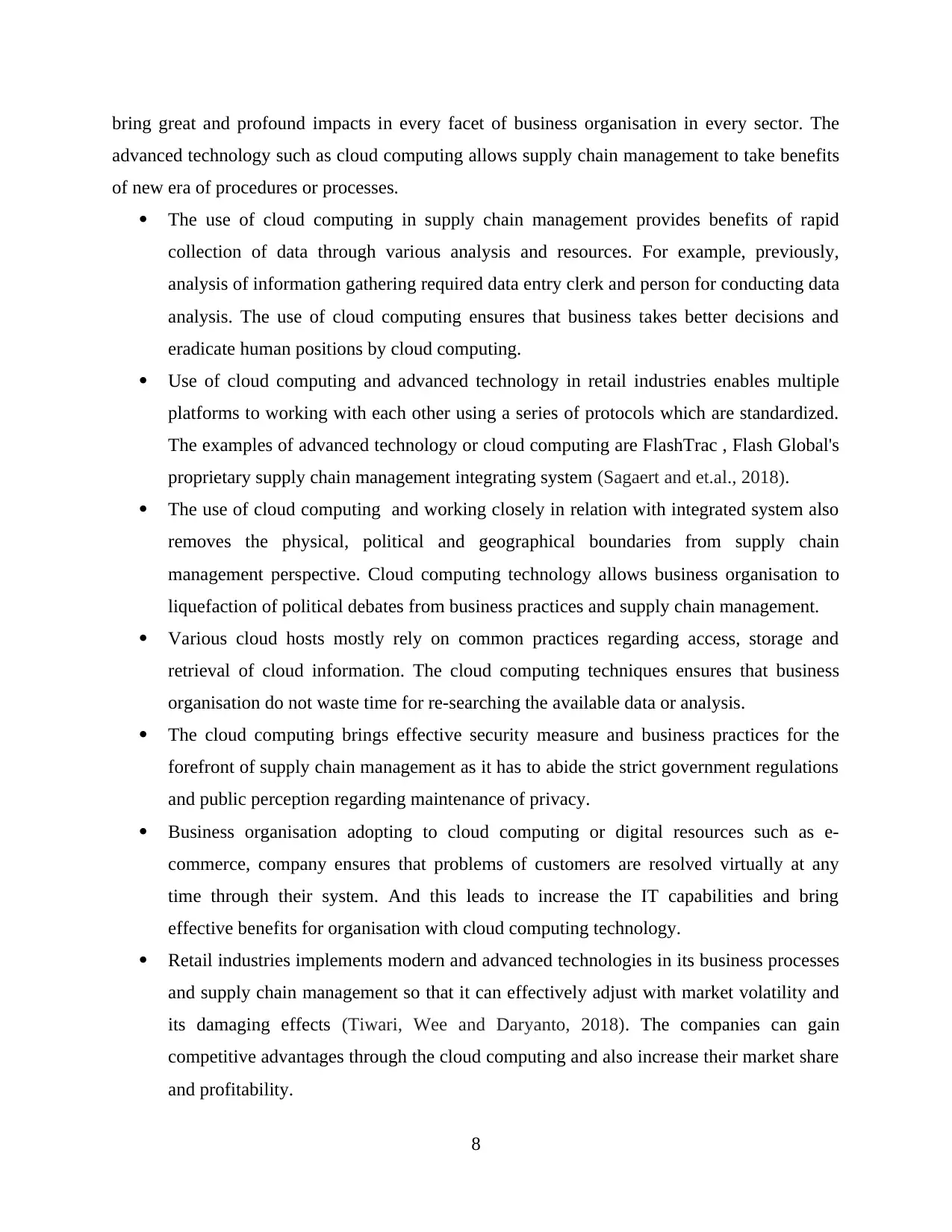
bring great and profound impacts in every facet of business organisation in every sector. The
advanced technology such as cloud computing allows supply chain management to take benefits
of new era of procedures or processes.
The use of cloud computing in supply chain management provides benefits of rapid
collection of data through various analysis and resources. For example, previously,
analysis of information gathering required data entry clerk and person for conducting data
analysis. The use of cloud computing ensures that business takes better decisions and
eradicate human positions by cloud computing.
Use of cloud computing and advanced technology in retail industries enables multiple
platforms to working with each other using a series of protocols which are standardized.
The examples of advanced technology or cloud computing are FlashTrac , Flash Global's
proprietary supply chain management integrating system (Sagaert and et.al., 2018).
The use of cloud computing and working closely in relation with integrated system also
removes the physical, political and geographical boundaries from supply chain
management perspective. Cloud computing technology allows business organisation to
liquefaction of political debates from business practices and supply chain management.
Various cloud hosts mostly rely on common practices regarding access, storage and
retrieval of cloud information. The cloud computing techniques ensures that business
organisation do not waste time for re-searching the available data or analysis.
The cloud computing brings effective security measure and business practices for the
forefront of supply chain management as it has to abide the strict government regulations
and public perception regarding maintenance of privacy.
Business organisation adopting to cloud computing or digital resources such as e-
commerce, company ensures that problems of customers are resolved virtually at any
time through their system. And this leads to increase the IT capabilities and bring
effective benefits for organisation with cloud computing technology.
Retail industries implements modern and advanced technologies in its business processes
and supply chain management so that it can effectively adjust with market volatility and
its damaging effects (Tiwari, Wee and Daryanto, 2018). The companies can gain
competitive advantages through the cloud computing and also increase their market share
and profitability.
8
advanced technology such as cloud computing allows supply chain management to take benefits
of new era of procedures or processes.
The use of cloud computing in supply chain management provides benefits of rapid
collection of data through various analysis and resources. For example, previously,
analysis of information gathering required data entry clerk and person for conducting data
analysis. The use of cloud computing ensures that business takes better decisions and
eradicate human positions by cloud computing.
Use of cloud computing and advanced technology in retail industries enables multiple
platforms to working with each other using a series of protocols which are standardized.
The examples of advanced technology or cloud computing are FlashTrac , Flash Global's
proprietary supply chain management integrating system (Sagaert and et.al., 2018).
The use of cloud computing and working closely in relation with integrated system also
removes the physical, political and geographical boundaries from supply chain
management perspective. Cloud computing technology allows business organisation to
liquefaction of political debates from business practices and supply chain management.
Various cloud hosts mostly rely on common practices regarding access, storage and
retrieval of cloud information. The cloud computing techniques ensures that business
organisation do not waste time for re-searching the available data or analysis.
The cloud computing brings effective security measure and business practices for the
forefront of supply chain management as it has to abide the strict government regulations
and public perception regarding maintenance of privacy.
Business organisation adopting to cloud computing or digital resources such as e-
commerce, company ensures that problems of customers are resolved virtually at any
time through their system. And this leads to increase the IT capabilities and bring
effective benefits for organisation with cloud computing technology.
Retail industries implements modern and advanced technologies in its business processes
and supply chain management so that it can effectively adjust with market volatility and
its damaging effects (Tiwari, Wee and Daryanto, 2018). The companies can gain
competitive advantages through the cloud computing and also increase their market share
and profitability.
8
Paraphrase This Document
Need a fresh take? Get an instant paraphrase of this document with our AI Paraphraser
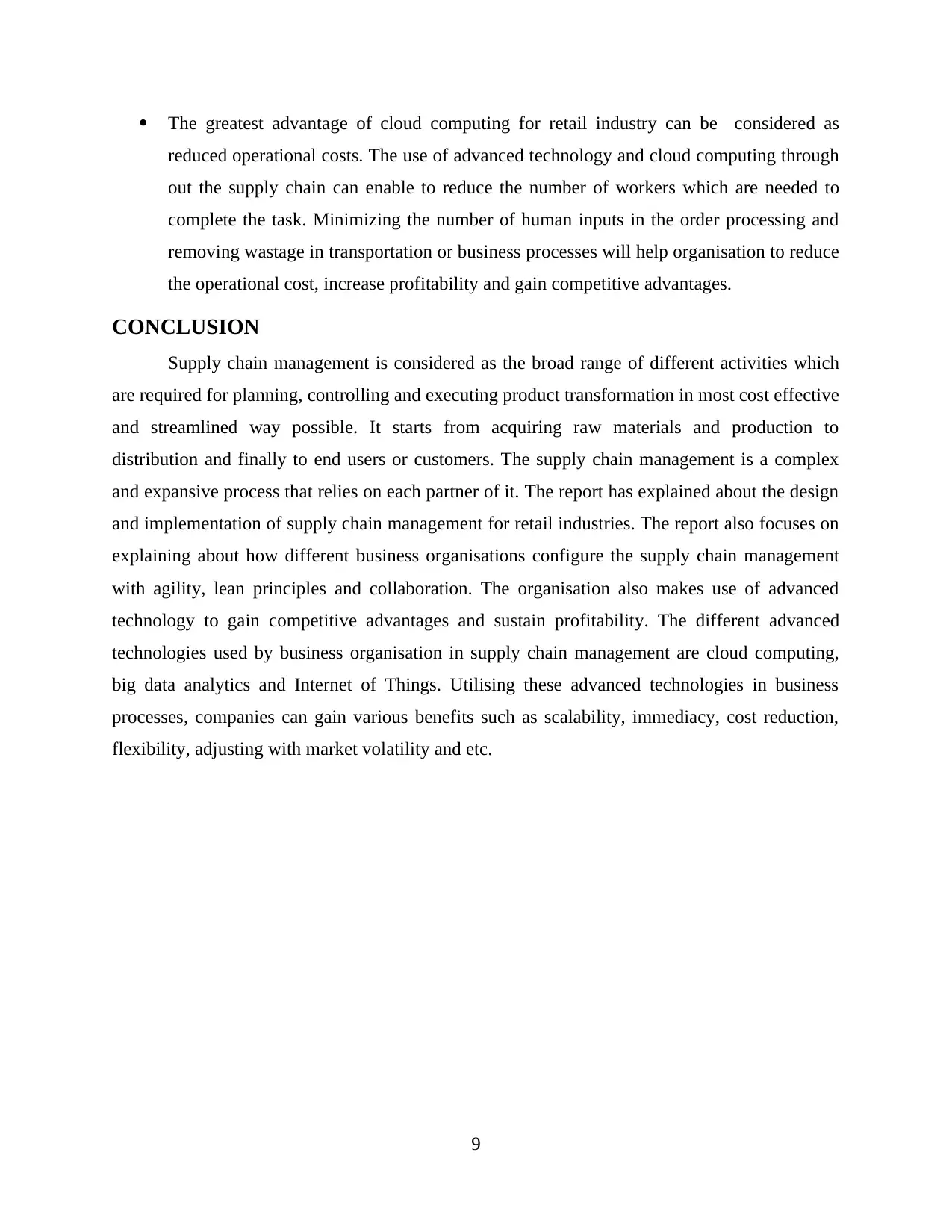
The greatest advantage of cloud computing for retail industry can be considered as
reduced operational costs. The use of advanced technology and cloud computing through
out the supply chain can enable to reduce the number of workers which are needed to
complete the task. Minimizing the number of human inputs in the order processing and
removing wastage in transportation or business processes will help organisation to reduce
the operational cost, increase profitability and gain competitive advantages.
CONCLUSION
Supply chain management is considered as the broad range of different activities which
are required for planning, controlling and executing product transformation in most cost effective
and streamlined way possible. It starts from acquiring raw materials and production to
distribution and finally to end users or customers. The supply chain management is a complex
and expansive process that relies on each partner of it. The report has explained about the design
and implementation of supply chain management for retail industries. The report also focuses on
explaining about how different business organisations configure the supply chain management
with agility, lean principles and collaboration. The organisation also makes use of advanced
technology to gain competitive advantages and sustain profitability. The different advanced
technologies used by business organisation in supply chain management are cloud computing,
big data analytics and Internet of Things. Utilising these advanced technologies in business
processes, companies can gain various benefits such as scalability, immediacy, cost reduction,
flexibility, adjusting with market volatility and etc.
9
reduced operational costs. The use of advanced technology and cloud computing through
out the supply chain can enable to reduce the number of workers which are needed to
complete the task. Minimizing the number of human inputs in the order processing and
removing wastage in transportation or business processes will help organisation to reduce
the operational cost, increase profitability and gain competitive advantages.
CONCLUSION
Supply chain management is considered as the broad range of different activities which
are required for planning, controlling and executing product transformation in most cost effective
and streamlined way possible. It starts from acquiring raw materials and production to
distribution and finally to end users or customers. The supply chain management is a complex
and expansive process that relies on each partner of it. The report has explained about the design
and implementation of supply chain management for retail industries. The report also focuses on
explaining about how different business organisations configure the supply chain management
with agility, lean principles and collaboration. The organisation also makes use of advanced
technology to gain competitive advantages and sustain profitability. The different advanced
technologies used by business organisation in supply chain management are cloud computing,
big data analytics and Internet of Things. Utilising these advanced technologies in business
processes, companies can gain various benefits such as scalability, immediacy, cost reduction,
flexibility, adjusting with market volatility and etc.
9
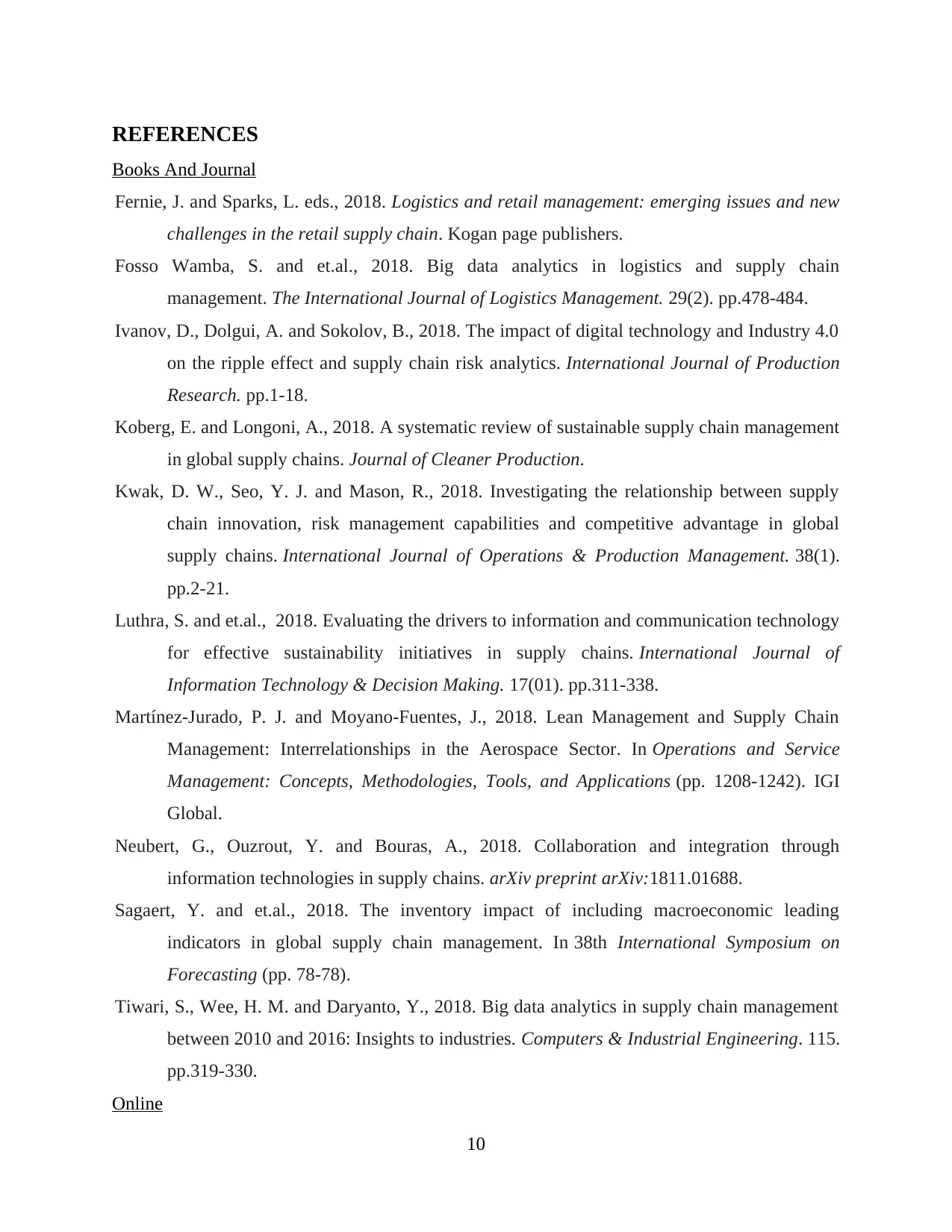
REFERENCES
Books And Journal
Fernie, J. and Sparks, L. eds., 2018. Logistics and retail management: emerging issues and new
challenges in the retail supply chain. Kogan page publishers.
Fosso Wamba, S. and et.al., 2018. Big data analytics in logistics and supply chain
management. The International Journal of Logistics Management. 29(2). pp.478-484.
Ivanov, D., Dolgui, A. and Sokolov, B., 2018. The impact of digital technology and Industry 4.0
on the ripple effect and supply chain risk analytics. International Journal of Production
Research. pp.1-18.
Koberg, E. and Longoni, A., 2018. A systematic review of sustainable supply chain management
in global supply chains. Journal of Cleaner Production.
Kwak, D. W., Seo, Y. J. and Mason, R., 2018. Investigating the relationship between supply
chain innovation, risk management capabilities and competitive advantage in global
supply chains. International Journal of Operations & Production Management. 38(1).
pp.2-21.
Luthra, S. and et.al., 2018. Evaluating the drivers to information and communication technology
for effective sustainability initiatives in supply chains. International Journal of
Information Technology & Decision Making. 17(01). pp.311-338.
Martínez-Jurado, P. J. and Moyano-Fuentes, J., 2018. Lean Management and Supply Chain
Management: Interrelationships in the Aerospace Sector. In Operations and Service
Management: Concepts, Methodologies, Tools, and Applications (pp. 1208-1242). IGI
Global.
Neubert, G., Ouzrout, Y. and Bouras, A., 2018. Collaboration and integration through
information technologies in supply chains. arXiv preprint arXiv:1811.01688.
Sagaert, Y. and et.al., 2018. The inventory impact of including macroeconomic leading
indicators in global supply chain management. In 38th International Symposium on
Forecasting (pp. 78-78).
Tiwari, S., Wee, H. M. and Daryanto, Y., 2018. Big data analytics in supply chain management
between 2010 and 2016: Insights to industries. Computers & Industrial Engineering. 115.
pp.319-330.
Online
10
Books And Journal
Fernie, J. and Sparks, L. eds., 2018. Logistics and retail management: emerging issues and new
challenges in the retail supply chain. Kogan page publishers.
Fosso Wamba, S. and et.al., 2018. Big data analytics in logistics and supply chain
management. The International Journal of Logistics Management. 29(2). pp.478-484.
Ivanov, D., Dolgui, A. and Sokolov, B., 2018. The impact of digital technology and Industry 4.0
on the ripple effect and supply chain risk analytics. International Journal of Production
Research. pp.1-18.
Koberg, E. and Longoni, A., 2018. A systematic review of sustainable supply chain management
in global supply chains. Journal of Cleaner Production.
Kwak, D. W., Seo, Y. J. and Mason, R., 2018. Investigating the relationship between supply
chain innovation, risk management capabilities and competitive advantage in global
supply chains. International Journal of Operations & Production Management. 38(1).
pp.2-21.
Luthra, S. and et.al., 2018. Evaluating the drivers to information and communication technology
for effective sustainability initiatives in supply chains. International Journal of
Information Technology & Decision Making. 17(01). pp.311-338.
Martínez-Jurado, P. J. and Moyano-Fuentes, J., 2018. Lean Management and Supply Chain
Management: Interrelationships in the Aerospace Sector. In Operations and Service
Management: Concepts, Methodologies, Tools, and Applications (pp. 1208-1242). IGI
Global.
Neubert, G., Ouzrout, Y. and Bouras, A., 2018. Collaboration and integration through
information technologies in supply chains. arXiv preprint arXiv:1811.01688.
Sagaert, Y. and et.al., 2018. The inventory impact of including macroeconomic leading
indicators in global supply chain management. In 38th International Symposium on
Forecasting (pp. 78-78).
Tiwari, S., Wee, H. M. and Daryanto, Y., 2018. Big data analytics in supply chain management
between 2010 and 2016: Insights to industries. Computers & Industrial Engineering. 115.
pp.319-330.
Online
10
⊘ This is a preview!⊘
Do you want full access?
Subscribe today to unlock all pages.

Trusted by 1+ million students worldwide
1 out of 13
Related Documents
Your All-in-One AI-Powered Toolkit for Academic Success.
+13062052269
info@desklib.com
Available 24*7 on WhatsApp / Email
![[object Object]](/_next/static/media/star-bottom.7253800d.svg)
Unlock your academic potential
Copyright © 2020–2025 A2Z Services. All Rights Reserved. Developed and managed by ZUCOL.





